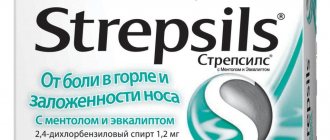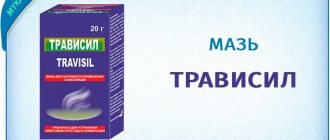Pharmacological properties of the drug Gastal
a buffer antacid that reduces the increased acidity of gastric juice and eliminates the unwanted reactions it causes (pain, heartburn, etc.). The optimal ratio of active components in the composition of the drug ensures the antacid effect of Gastal, characterized by a decrease in acidity to a certain extent, as well as a quickly onset and long-lasting effect (within 2 hours). The gel of aluminum hydroxide and magnesium carbonate is a buffer antacid substance that reduces the increased acidity of gastric juice to physiological limits (pH 3.0–5.0) and thus ensures a normal digestion process without subsequent hypersecretion. Aluminum hydroxide adsorbs and precipitates pepsin in gastric juice, reversibly inactivating it. Magnesium hydroxide is a non-absorbable, non-buffered antacid. It has a pronounced, quickly-onset and long-lasting neutralizing effect, in addition, it exhibits a laxative effect. In combination with aluminum hydroxide, it enhances the antacid effect and reduces the likelihood of constipation. Aluminum hydroxide, after reacting with hydrochloric acid of gastric juice in an alkaline environment, forms compounds with phosphates and carbonates and is excreted in the feces in the form of insoluble salts. After a chemical reaction, magnesium hydroxide is excreted from the body in feces, also in the form of insoluble salts. In patients with normal renal function, Gastal does not have a systemic effect, since it is absorbed in the digestive tract in very small quantities and is quickly excreted in the urine.
Gastal
Gastal ®
(lat.
Gastal ®
) is an antacid drug intended for the treatment of diseases of the digestive tract, the mechanism of action of which is based on the neutralization of gastric acid. According to the pharmacological index, gastal belongs to antacids and adsorbents. For ATC - to the group of antacids, subgroup “Antacids in combination with other drugs”, code A02AX.
Composition of the drug Gastal
Active substances:
one tablet of gastal contains 450 mg of hydrotalcite and 300 mg of magnesium hydroxide.
Excipients
(for the drug in tablets): mannitol, sorbitol, lactose, corn starch, sodium cyclamate, sodium saccharinate, talc, magnesium stearate, peppermint flavor.
Gastal release forms
- pills
- cherry lozenges
- mint lozenges
Pharmacological action of Gastal
Gastal is a combined antacid drug for oral administration.
Reduces the increased acidity of gastric juice to a physiological level and eliminates dyspeptic disorders by neutralizing excess hydrochloric acid in the stomach. The magnesium hydroxide and aluminum hydroxide included in gastal provide rapid and long-term neutralization, causing an antacid effect. The antacid effect of the drug appears immediately after taking Gastal tablets and lasts about 2 hours. 1 tablet of gastal neutralizes about 21.5 mmol of hydrochloric acid. Gastal inhibits the action of pepsin, lysolecithin and bile acids, thus also eliminating gastric dysfunction. Gastal, in addition to its antacid effect, activates protective and regenerative mechanisms in the gastric mucosa. The cytoprotective effect caused by aluminum ions includes stimulation of the secretion of mucus and sodium bicarbonate in the stomach, the accumulation of epidermal growth factor at the site of damage, an increase in the concentration of phospholipids in the stomach and other mechanisms.
Gastal has no systemic effect in patients with normal renal function. After interacting with the hydrochloric acid of gastric juice, aluminum hydroxide reacts with phosphates and carbonates in the alkaline environment of the intestine and is excreted in the feces in the form of insoluble salts. Magnesium hydroxide reacts with hydrochloric acid in gastric juice to form magnesium chloride, which has an osmotic laxative effect in the small intestine. Magnesium is also excreted in the feces as insoluble carbonate.
Indications for use of Gastal
Heartburn (after taking medications, alcohol, coffee; dietary errors, nicotine abuse, etc.); conditions accompanied by increased acid formation: gastritis, gastric and duodenal ulcers; symptomatic ulcers of various origins; erosion of the gastric mucosa of the upper gastrointestinal tract; reflux esophagitis; hiatal hernia; acute pancreatitis, exacerbation of chronic pancreatitis (as part of combination therapy). Fermentative or putrefactive dyspepsia (as part of combination therapy).
Contraindications to the use of Gastal
Hypersensitivity, chronic renal failure, Alzheimer's disease, hypophosphatemia, children under 6 years of age. With caution: children under 12 years of age. During lactation and pregnancy, only as prescribed and under the supervision of a physician.
Method of administration of Gastal and dose
Gastal is taken orally. The Gastal tablet should be dissolved gradually (do not swallow whole). Adults are recommended to take Gastal an hour after meals and before bedtime, 1-2 tablets 4-6 times a day, but not more than 8 tablets within 24 hours. The duration of taking Gastal should not exceed 2 weeks. For prophylaxis, Gastal is used before the expected irritant effect on the mucous membrane of the gastrointestinal tract. Similar doses are recommended for heartburn, regardless of food intake. For children aged 6–12 years, half the adult dose is recommended.
For patients with low weight and children, Gastal is used in smaller doses and for a shorter period of time. Patients with impaired renal function are not recommended to use Gastal for a longer period and in higher doses than recommended. Continuous use for more than 2 weeks - only after consulting a doctor. As with all other medications, use during pregnancy
Gastala is possible only in special cases and only on the recommendation of a doctor.
Side effects of Gastal
Rarely - allergic reactions, nausea, vomiting, changes in taste, diarrhea, constipation.
With long-term use in high doses of drugs containing aluminum and magnesium, the development of hypophosphatemia, hypocalcemia, hypercalciuria, osteomalacia, osteoporosis, hypermagnesemia, hyperaluminemia, encephalopathy, nephrocalcinosis and impaired renal function is possible. Increased side effects from the gastrointestinal tract (constipation, diarrhea) are possible. In patients with concomitant renal failure - thirst, decreased blood pressure, hyporeflexia. If these symptoms appear, symptomatic treatment should be carried out.
Interaction of Gastal with other drugs
The interval between taking Gastal and other medications should be 1-2 hours.
Gastal enhances the activity of levodopa and nalidixic acid; reduces and slows down the absorption of tetracycline antibiotics, ciproflocacin and ofloxacin, salicylates, isoniazid, naproxen, iron preparations, cardiac glycosides, indomethacin, aminazine, phenytoin, H2-blockers, beta-blockers, diflunisal, fat-soluble vitamins, indirect anticoagulants, barbiturates.
M-anticholinergic blockers, by slowing down gastric emptying, enhance and prolong the effect of gastal.
Gastal does not affect the ability to drive a car or operate other mechanisms.
Gastal is an over-the-counter product.
Manufacturers:
Pliva Krakow, Pharmaceutical Plant A.O., Poland, Pliva Hrvatska d.o.o., Croatia.
Instructions from the manufacturer (pdf):
- “Instructions for medical use of the drug Gastal (tablets)”
- “Instructions for medical use of the drug Gastal (lozenges, mint and cherry)”
Professional medical works that discuss the use of gastal in the treatment of gastrointestinal diseases
- Zvyagin A.A. Functional dyspepsia and chronic gastritis in children. Optimization of diagnosis, treatment and rehabilitation. Abstract of dissertation. Doctor of Medical Sciences, 14.00.09 - pediatrics. VSMA, Voronezh, 2006.
- Belmer S.V., Kovalenko A.A., Gasilina T.V. Antacid drugs in modern clinical practice // Doctor.ru. – 2004. – No. 4. – p. 19–22.
On the website gastroscan.ru in the literature catalog there is a section “Antacids”, containing articles devoted to the treatment of diseases of the gastrointestinal tract with antacids, including Gastal.
Gastal has contraindications, side effects and application features; consultation with a specialist is necessary.
Back to section
Indications for use of the drug Gastal
Increased acidity of gastric juice with peptic ulcers of the stomach and duodenum; reflux esophagitis; acute and chronic gastritis; dyspepsia; irritation of the gastric mucosa caused by smoking or dietary errors (for example, drinking alcohol, coffee, sweets); heartburn (as a result of increased acidity) in pregnant women, the elderly and other patients for whom the use of an antacid that does not cause constipation and other undesirable effects is indicated.
Gastal, 450 mg+300 mg, lozenges, mint flavor, 48 pcs.
Common to all dosage forms:
The drug Gastal®, when used simultaneously, enhances the activity of levodopa and nalidixic acid, reduces and slows down the absorption of quinolones, isoniazid, naproxen, iron supplements, indomethacin, aminazine, β-blockers, diflunisal, histamine H2 receptor blockers, fat-soluble vitamins (A, D, E , K), indirect anticoagulants, barbiturates and cardiac glycosides.
M-anticholinergic blockers, by slowing down gastric motility, increase the duration of action of the drug Gastal®.
For lozenges additionally
When interacting with metal ions included in antacids, tetracyclines form insoluble chelate complexes; as a result of this interaction, the absorption of tetracyclines is reduced by more than 90%. The simultaneous use of these drugs is not possible. If combined use is necessary, tetracycline should be taken at least 2 hours before taking the antacid.
In the presence of aluminum and magnesium hydroxides contained in the antacid, the absorption of ciprofloxacin and ofloxacin is reduced by 50–90%.
In the presence of antacids, the bioavailability of captopril is significantly reduced, and the combined use of antacids and metoprolol leads to a decrease in the concentration of metoprolol in the blood plasma.
Concomitant use of high doses of antacids may reduce the absorption of ranitidine by 10–33%.
The use of antacids does not affect the bioavailability of amoxicillin, cephalexin and the combination of amoxicillin and clavulanic acid, but can significantly reduce the absorption of doxycycline from the gastrointestinal tract.
An increase in urine pH during antacid therapy can increase the tubular reabsorption of basic (alkaline) drugs and reduce the reabsorption of acidic compounds.
Antacids can reduce and slow down the absorption of salicylates, incl. acetylsalicylic acid, and also, by increasing the pH of urine, promote faster excretion of salicylates in the urine from the body, with a concomitant decrease in their concentration in the blood serum by 30–70%.
Absorption of cardiac glycosides, incl. Digoxin and digitoxin, when used simultaneously with antacids, does not decrease significantly.
In order to prevent possible interaction of the drug Gastal® with other drugs, it is recommended to take it 1 hour before or 2 hours after their use.
Gastal, 12 pcs., lozenges
Common to all dosage forms:
The drug Gastal®, when used simultaneously, enhances the activity of levodopa and nalidixic acid, reduces and slows down the absorption of quinolones, isoniazid, naproxen, iron supplements, indomethacin, aminazine, β-blockers, diflunisal, histamine H2 receptor blockers, fat-soluble vitamins (A, D, E , K), indirect anticoagulants, barbiturates and cardiac glycosides.
M-anticholinergic blockers, by slowing down gastric motility, increase the duration of action of the drug Gastal®.
For lozenges additionally
When interacting with metal ions included in antacids, tetracyclines form insoluble chelate complexes; as a result of this interaction, the absorption of tetracyclines is reduced by more than 90%. The simultaneous use of these drugs is not possible. If combined use is necessary, tetracycline should be taken at least 2 hours before taking the antacid.
In the presence of aluminum and magnesium hydroxides contained in the antacid, the absorption of ciprofloxacin and ofloxacin is reduced by 50–90%.
In the presence of antacids, the bioavailability of captopril is significantly reduced, and the combined use of antacids and metoprolol leads to a decrease in the concentration of metoprolol in the blood plasma.
Concomitant use of high doses of antacids may reduce the absorption of ranitidine by 10–33%.
The use of antacids does not affect the bioavailability of amoxicillin, cephalexin and the combination of amoxicillin and clavulanic acid, but can significantly reduce the absorption of doxycycline from the gastrointestinal tract.
An increase in urine pH during antacid therapy can increase the tubular reabsorption of basic (alkaline) drugs and reduce the reabsorption of acidic compounds.
Antacids can reduce and slow down the absorption of salicylates, incl. acetylsalicylic acid, and also, by increasing the pH of urine, promote faster excretion of salicylates in the urine from the body, with a concomitant decrease in their concentration in the blood serum by 30–70%.
Absorption of cardiac glycosides, incl. Digoxin and digitoxin, when used simultaneously with antacids, does not decrease significantly.
In order to prevent possible interaction of the drug Gastal® with other drugs, it is recommended to take it 1 hour before or 2 hours after their use.

